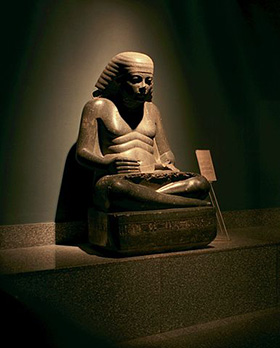New Kingdom Architects
- Neolithic Period: 4500-3000 BCE
- Early Dynastic: 3000-2650 BCE
- Old Kingdom: 2650-2150 BCE
- 1st Intermediate Period: 2150-2040 BCE
- Middle Kingdom: 2040-1640 BCE
- 2nd Intermediate Period: 1640-1550 BCE
- New Kingdom: 1550-1070 BCE
- - Architects: Amenhotep, Son of Hapu
- - Architects: Senenmut
- - Rulers: Amenhotep III
- - Rulers: Amenhotep IV
- - Rulers: Hatshepsut
- - Rulers: Ramses II
- - Rulers: Ramses III
- - Rulers: Thutmose III
- - Rulers: Tutankhamun
- - Monuments: Abu-Simbel
- - Monuments: Abydos - The Temple of Seti
- - Monuments: Akhetaton (Tell el-Amarna)
- - Monuments: Amenhotep III’s Mortuary Complex
- - Monuments: Deir-el-Bahri
- - Monuments: Luxor Temple
- - Artifacts: Link to Collection Search
- 3rd Intermediate Period: 1070-712 BCE
- Saite and Late Periods: 712-332 BCE
- Greco-Roman Period: 332 BCE-642 CE
- Coptic Period: 395-642 CE
- Islamic Period and Modern Times: 642 CE-Today
- Neolithic Period: 4500-3000 BCE
- Early Dynastic: 3000-2650 BCE
- Old Kingdom: 2650-2150 BCE
- 1st Intermediate Period: 2150-2040 BCE
- Middle Kingdom: 2040-1640 BCE
- 2nd Intermediate Period: 1640-1550 BCE
- New Kingdom: 1550-1070 BCE
- - Architects: Amenhotep, Son of Hapu
- - Architects: Senenmut
- - Rulers: Amenhotep III
- - Rulers: Amenhotep IV
- - Rulers: Hatshepsut
- - Rulers: Ramses II
- - Rulers: Ramses III
- - Rulers: Thutmose III
- - Rulers: Tutankhamun
- - Monuments: Abu-Simbel
- - Monuments: Abydos - The Temple of Seti
- - Monuments: Akhetaton (Tell el-Amarna)
- - Monuments: Amenhotep III’s Mortuary Complex
- - Monuments: Deir-el-Bahri
- - Monuments: Luxor Temple
- - Artifacts: Link to Collection Search
- 3rd Intermediate Period: 1070-712 BCE
- Saite and Late Periods: 712-332 BCE
- Greco-Roman Period: 332 BCE-642 CE
- Coptic Period: 395-642 CE
- Islamic Period and Modern Times: 642 CE-Today
Amenhotep, Son of Hapu
ca. 1430 – 1350 BCE
Amenhotep, the son of Hapu and Lady Itu, was a very influential Egyptian noble with a brilliant mind who lived during the reign of Amenhotep III in the fifteenth century BCE. He began as a scribe of military recruits and quickly worked his way up through the ranks, gaining a highly respected and influential status. He went on to hold several important positions, including as a well-known architect for the pharaoh, as the steward of the pharaoh's daughter, and as a military officer of high rank. He was also promoted to “Chief of the Pharaoh,” with the responsibility of recruiting and organizing labor across all of Egypt for the pharaoh's projects. He believed that over his lifetime he gained wisdom and learned magic from the deities.
One of Amenhotep, Son of Hapu’s most famous architectural creations was Pharaoh Amenhotep III's mortuary temple in Thebes, near modern Luxor. The grandest of all mortuary complexes built in Egypt, it originally included three massive mud-brick pylons (gates) aligned on a single axis, and a long connecting corridor leading to an immense, open solar courtyard, a roofed hall, a sanctuary, and sacred altars.
When Amenhotep, Son of Hapu died, Pharaoh Amenhotep III ordered a small funerary temple built right next to his own funerary complex, an honor which had never been bestowed in such a way before.
After his death, Amenhotep, Son of Hapu’s reputation grew and he was esteemed as a philosopher for his teachings. He was also revered as a healer and eventually worshipped as a god of healing, like his predecessor Imhotep.

Image: Amenhotep, Son of Hapu statue at the Luxor Museum, Egypt.
Photo credit: By Jerzy Strzelecki - Own work, CC BY 3.0
http://www.academia.edu/4440012/Amenhotep_Son_of_Hapu-_Oxford_eEncyclopedia_of_the_Ancient_World
Galan, Jose M. Egyptology at the Dawn of the Twenty-First Century, Proceedings of the Eighth International Congress of Egyptologists, Cairo, 2000. The American University in Cairo Press, Cairo, New York, 2000.
https://henadology.wordpress.com/theology/netjeru/amenhotep-son-of-hapu/

